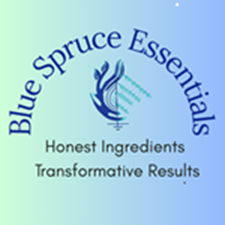
Dehydrated or Dry? How to Tell & What to Do (Especially After 40)
Share
Here’s the thing about skin after 40: it starts acting differently without warning. You know that tight feeling everyone complains about? Might not be what you think. But is your skin truly dry, or is it dehydrated? Understanding the difference is crucial for selecting the right skincare and keeping your skin healthy, radiant, and youthful.
In this article, we’ll explore:
- Why are people over 40 more prone to dry skin and dehydrated skin
- The difference between dry skin and dehydrated skin (and how to tell)
- How these conditions accelerate visible aging
- Science-backed strategies to restore hydration
- The best ingredients for lasting moisture (and how Blue Spruce Essentials uses them)
Why People Over 40 Are More Prone to Dryness and Dehydration
Natural Aging Process: As we age, our sebaceous glands produce less oil. This reduction in sebum leads to dry skin, meaning a lack of lipids or oil.
Slower Cell Turnover: Cell turnover drags its feet, too. It takes longer to fix itself, which means moisture slips out more easily.
Weakened Skin Barrier: And that protective outer layer (stratum corneum)? Gets leaky over time like a screen door that won’t shut right
Hormonal Shifts: Then there are hormones, estrogen dips during perimenopause and menopause mess with collagen, elastin, and lipids, all the stuff that keeps moisture locked in
Environmental & Lifestyle Factors: Don’t even get me started on decades of sun damage, office AC blasting, and stress! This leads to an increase in trans-epidermal water loss (TEWL), the process by which water evaporates from the skin.
Dry vs. Dehydrated Skin: What’s the Difference?
| Dry Skin | Dehydrated Skin | |
|---|---|---|
| Cause | Lack of oil/lipids | Lack of water/moisture |
| Skin type | Genetic (a skin type) | Temporary condition |
| Feel | Rough, flaky, tight | Tight, dull, fine lines, even oily |
| Treatment | Rich oils, occlusives | Hydrating serums, humectants |
In a nutshell:
🔹 Dry Skin = Lack of Oil
Your skin isn’t producing enough sebum (natural oil). This is a skin type, often genetic, and tends to persist over time.
🔹 Dehydrated Skin = Lack of Water
This is a condition, not a skin type.
Pro tip: You can be oily and dehydrated! Dehydrated skin often overcompensates by producing more sebum, which leads many to mistreat it with drying products.
How Dry Skin or Dehydrated Skin Accelerates Signs of Aging
When skin is dry or dehydrated:
- Wrinkles appear more prominent because there’s not enough moisture to plump the skin.
- The skin barrier weakens, making skin more sensitive, red, or inflamed.
- Loss of elasticity leads to sagging and a dull, fatigued appearance.
According to a 2020 clinical review in the Journal of Clinical and Aesthetic Dermatology, hydration is key to collagen health. Skin can’t repair itself without water, resulting in speeding up aging if you ignore it. Not ideal.
Science-Backed Hydration Strategies for Healthy Aging Skin
- Use Multi-Weight Humectants like glycerin and hyaluronic acid to attract water to different layers of the skin.
- Layer Lipids with emollients like jojoba, almond, or pomegranate oil to restore the lipid barrier and prevent water loss.
- Seal It In with natural occlusives like plant waxes or shea butter to trap moisture.
- Avoid Harsh Cleansers that strip oils; choose sulfate-free options that respect the skin barrier.
- Stay Hydrated Internally — hydration starts inside-out, especially for aging skin. Don’t ignore the power of water, omega-3s, and antioxidant-rich foods.
Hydrating Ingredients That Help (and How Blue Spruce Essentials Uses Them)
At Blue Spruce Essentials, our formulations are intentionally crafted for dry skin and dehydrated skin, especially for people in their 40s and beyond.
- Honey: Both Barrier Boost and Kojic Kiss contain clinical levels of honey, a natural humectant that hydrates deeply while delivering antioxidants and antibacterial benefits.
- Niacinamide (Vitamin B3): Found in both creams, it improves the skin barrier and enhances moisture retention while also addressing pigmentation and fine lines.
- Cold-Pressed Botanical Oils:
- Jojoba oil mimics the skin’s sebum, helping to regulate oil production and deeply nourish.
- Almond oil soothes and softens while delivering vitamins A and E.
- Pomegranate oil provides punicic acid (Omega-5), which repairs and strengthens the skin.
- Hydrolyzed Quinoa Protein and Aloe Vera: Offer moisture-binding and anti-inflammatory benefits to calm and smooth the skin.
Together, these ingredients don’t just hydrate, they rejuvenate, protect, and strengthen mature skin for the long term.
Keep It Simple
Truth bomb: You don’t need a 10-step routine, you need a smart one. Figure out if you’re dry first or if you're dehydrated first. Then hit it with targeted ingredients. By prioritizing hydration and barrier support with clinically effective, plant-powered ingredients, you can keep your skin looking radiant, plump, and healthy, no matter your age.
Next time your face feels tight, don’t just slap on moisturizer, check what’s missing: Oils? Water? Both? Treat it with care, and that 40+ skin stays bouncy for years.
✨ Ready to support your skin, your way?
Explore our pro-aging essentials at Blue Spruce Essentials, where science meets self-care.
